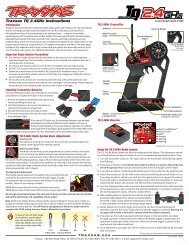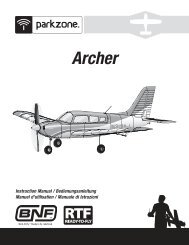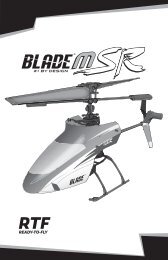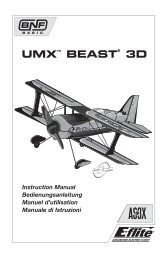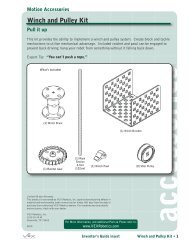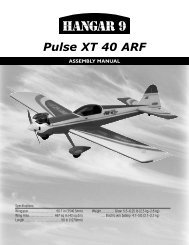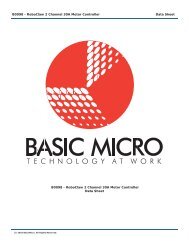Manual
Manual
Manual
- No tags were found...
You also want an ePaper? Increase the reach of your titles
YUMPU automatically turns print PDFs into web optimized ePapers that Google loves.
y Great Planes ® Model Stock #35-30-950 .................GPMG459035-30-1250 ...............GPMG459535-30-1450 ...............GPMG460035-36-1000 ...............GPMG4615RIMFIRE 35mm POWER SYSTEM35-36-1200 ...............GPMG462035-36-1500 ...............GPMG462535-48-700 .................GPMG463535-48-850 .................GPMG464035-48-1000 ...............GPMG464535-48-1300 ...............GPMG465035-48-1600 ...............GPMG4655The RimFire motors are labeled to provide themost information at a glance. For example: the35-48-850kV is 35mm in diameter, 48mm longand has a kV (rpm-per-volt) of 850 rpm.35mmMOTORS30mm, 36mm OR 48mm4mmELECTRONIC SPEED CONTROL (ESC)An ESC is basically the device that controlsyour motor through your radio system. Neverrun any RimFire motors with a brushed ESC.It will not work and you may damage both themotor and the ESC. Always use a brushlessESC. ElectriFly offers Brushless ESCs thatwill work with the RimFire 35mm motors.• ElectriFly Silver Series 45 (SS-45) ESC(GPMM1840) for 45A maximum constantcurrent draw.• The Silver Series 60 (SS-60) ESC(GPMM1850) for 60A maximum constantcurrent draw.• The Silver Series 80 (SS-80) ESC(GPMM1860) for 80A maximum constantcurrent draw.Congratulations, you have just purchased theRimFire 35mm power system components. Allthe components are sold separately to allowyou to customize your power system to yourairplane. The components needed to assembleyour RimFire 35mm power system are: RimFire35mm motors, propeller, propeller adaptersand brushless speed controls. This instructionsheet explains how to determine what you willneed and how to assemble each component.19mm19mm3mm Mount Screw17mmMotor Output ShaftDiameter and Length: 4x17mm [0.16"x0.68"]Weight (30mm): 71g [2.5oz.]Weight (36mm): 102g [3.6oz.]Weight (48mm): 170g [6.0oz.]These ESCs come with 4mm female bulletconnectors that require an adapter(GPMM3123) to plug into the 3.5mm maleconnectors installed on the RimFire 35mmmotors. Also, these ESCs come with aDeans ® Ultra Plug battery connector thatmatches the connectors that are found onmost batteries that it will use.
BRUSHLESS MEDIUM MOTOR MOUNT1. Front Plate (1)2. Back Plate (1)3. 4-40x1/4" SHC Screw (8)4. #4 Flat Washer (10)5. Motor Bracket (1, not used on RimFires)6. 4-40x1/2" SHC Screw (2)7. 4-40 Lock Nut (2)The ElectriFly Brushless Medium MotorMount combines the ease of installation withthe adjustability to fit most motor applications.The Medium Motor Mount is designed to fitthe bolt pattern of the Great Planes .20-.48and .40-.70 Nylon Engine Mount. This easilyallows the conversion of a glow poweredplane to electric powered.PROPELLERSThere is a wide selection of propellersavailable for electric use. The RimFire 35mmmotors use high performance slow fly electricprops. The larger the propeller used, the morecurrent your motor will draw. The smaller thepropeller, the less current the motor will draw.Shown are a few of the recommended electricprops. Due to the large range of propellersand the constant addition of new sizes, visitour web sites at www.electrifly.com andwww.greatplanes.com for the most up-todatelisting of electric type props.APCQ0945 ............9x4.5 ElectricAPCQ4118 ............9x6 ElectricAPCQ4120 ..........10x5 ElectricAPCQ4123 ..........10x7 ElectricAPCQ1055 ..........11x5.5 ElectricAPCQ4128 ..........11x7 ElectricAPCQ4129 ..........11x8 ElectricAPCQ4130 ..........12x6 ElectricAPCQ4136 ..........12x10 ElectricAPCQ3065 ..........13x6.5 ElectricAPCQ4022 ..........18x10 ElectricPROPELLER ADAPTERSThe RimFire 35mm motor comes with a propadapter that mounts directly to the motorcase. If the RimFire 35mm motor needs to bemounted so that the prop is mounted on themotor shaft, the motor requires a 4mm propadapter collet type (GPMQ4965), or set screwtype (GPMQ4936).GPMQ4936 4mm Set Screw TypeGPMQ4965 4mm Collet Type
BATTERIES: CHEMISTRYThe RimFire Motor/Silver Series ESCcombination can use NiMH or LiPo batteries.Typically, NiMH batteries are heavier but muchmore affordable for the same capacity as LiPobatteries. If you want a very light, highperformanceairplane, you might want to useLiPo batteries, but if weight is not a concern,then NiMH batteries might be for you.If a battery is arranged in PARALLEL it might belabeled as (P). Arranging the batteries in parallelwill give you more duration (more capacity).All LiPo batteries have a rated discharge thatmust not be exceeded or the battery will bedamaged. They may say 15C max. dischargerate or 20C max. discharge rate.This means thatthe discharge rate (current draw of the motor)must not be more than 15 or 20 (15C or 20C)times the capacity of the battery. The capacity isexpressed in milliamp hours (2100mAh). It canalso be expressed in amp hours (2.1 Ah).A LiPo battery with a capacity of 2100mAh witha 20C discharge rate can be discharged at 42amps, 2.1Ahx20C = 42 amps. If the powersystem draws more than 42 amps, the batterieswill have to be connected in parallel to increasethe capacity. Two 2100mAh batteries in parallelhave a capacity of 4200mAh or 4.2Ahx20C =84 amp discharge rate.ElectriFly offers a full line of NiMH and LiPobatteries. Airplanes that use the RimFire35mm motors will typically use batteries with acapacity of 2000 to 3600mAh with the highercapacity batteries delivering more flying timebut also being heavier. All of the batteries haveconnectors that fit the recommended ESCs.Due to the constantly changing batterytechnology, check out the ElectriFly web siteat www.electrifly.com for the most up-todatelisting of the ElectriFly battery line.BATTERIES: NUMBER OF CELLSCells can be connected in series or in parallel.Usually batteries are labeled as 8-cell NiMH or3-cell LiPo.This means the cells are connected inSERIES (S). Arranging batteries in series givesyou more power (higher voltage).• Each NiMH cell has 1.2V, so an 8-cellNiMH battery has 1.2x8 = 9.6V• Each LiPo battery has 3.7V, so a 3-cellLiPo battery has 3.7x3 = 11.1VIf you need a higher voltage than what isavailable in the LiPo battery line, you will needto connect two battery packs together in series.If you need a battery voltage of 14.8V you canuse the Series Y-Connector (GPMM3143) toconnect two 7.4V batteries together.Battery # ofStock # Voltage Capacity Weight Type CellsGPMP0616 7.4V 2100mAh 4.3oz (121g) LiPo 2GPMP0617 11.1V 2100mAh 6.4oz (181g) LiPo 3GPMP0622 7.4V 3200mAh 6.3oz (179g) LiPo 2GPMP0623 11.1V 3200mAh 9.5oz (269g) LiPo 3GPMP0350 7.2V 2000mAh 8.5oz (240g) NiMH 6GPMP0351 8.4V 2000mAh 12.2oz (345g) NiMH 7GPMP0352 9.6V 2000mAh 13.7oz (390g) NiMH 8GPMP0353 12V 2000mAh 16.7oz (475g) NiMH 10GPMP0361 8.4V 3600mAh 17.5oz (497g) NiMH 7GPMP0362 9.6V 3600mAh 19.9oz (564g) NiMH 8GPMP0363 12V 3600mAh 24.8oz (702g) NiMH 10GPMP0364 14.4V 3600mAh 29.6oz (840g) NiMH 12
DETERMINE WHAT YOU NEED TOBUILD YOUR POWER SYSTEMNow that you have a component for your power system,there are several different ways to select the rest of thecomponents of your power system. In time, experience willhelp you to determine what works best for you, but an easyway to determine what you need now is the following.PROCEDURE #1: If you know the size of the propeller youwant to turn and the rpm, then look at the chart included inthe packaging and:❏ 1. Find the combination in the motor/prop chart thatdelivers the closest performance to what you want.❏ 2. Note the recommended battery voltage.❏ 3. Determine if you want to use LiPo or NiMH batteriesbased on the desired ready-to-fly airplane weight.Select the number of cells based on the recommendedvoltage shown on the chart.❏ 4. Determine the battery capacity needed based on thecurrent draw of your system and your desired flight time.❏ 5. Determine the ESC you need based on the systemcurrent draw shown on the motor/prop chart. See theESC section.PROCEDURE #2: If you know the approximate weight ofyour airplane, including the motor and battery, and theperformance you want from it, answer the questions belowto determine the correct power system for your plane. Youmay need to make more than one calculation using differentmotors and battery combinations. See the battery section forsome of the battery weights for the suggested batteries.❏ 1. Perform the following calculation to determine thewattage required:• If you expect trainer-like performance then multiply75 x Airplane Weight (lbs)• If you expect aerobatic or high speed-like performancethen multiply 100 x Airplane Weight (lbs)• If you expect 3D or extreme performance multiply150 x Airplane Weight (lbs)❏ 2. The number you get is the minimum wattage you willneed for your plane to perform as you wish. Look at thechart and determine what combination gives you theperformance you want based on wattage andmaximum propeller size that will fit on the plane.❏ 3. Note the recommended battery voltage.❏ 4. Determine if you want to use LiPo or NiMH batteriesbased on the desired ready to fly airplane weight. Selectthe number of cells based on the recommended voltageshown in the chart.❏ 5. Determine the battery capacity needed based on thecurrent draw of your system and your desired flight time.❏ 6. Determine the ESC you need based on the systemcurrent draw.In addition to these two procedures, you can also visit theGreat Planes ElectriFly web site for descriptions of the powersystems recommended for our line of electric and glowairplanes as well as more detailed explanation on the subject.UNDERSTANDING MOTORSkV (rpm/volt): This is a number that gets thrown aroundquite a bit when talking electrics and it is important to knowwhat it is. kV is the number of rpm a motor will spin pereach volt applied (rpm/volt) under no load.This means that basically a motor that has a kV of 1000when connected to a 12V battery will try to spin at12,000rpm (1000x12) under no load. Likewise a 3500kVmotor will try to spin at 42,000rpm (3500x12) under no load.When a propeller is attached to the motor, the motor will tryto spin the prop at the rated kV. Depending on the diameterand pitch of the propeller (the larger the diameter or higherthe pitch, the harder it is to spin), the motor’s current drawcan be increased or decreased. There are meters availablefrom your hobby dealer that measure current and voltage.Because every motor has a maximum current it can takebased on its design and cooling ability, the maximum size ofpropeller that can be used with each motor can bedetermined.Too large of a propeller and the motor will spin ata much lower rpm than its rated kV, causing it to draw a lot ofcurrent and overheat. If the propeller/fan is too small, it willrequire little effort (current) to turn the prop at the rated kV.Ideally the motor should be matched with a propeller thatcauses the motor to draw 80-100% of its rated maximumconstant current. Once a power system is set up, it can befine-tuned by adjusting the propeller size and measuringthe amount of current the motor is drawing.Please note that the kV of a motor does not change withvoltage, but if a higher voltage is applied to the motor, it willtry to spin the same propeller at a higher rpm. This willcause the motor to draw more current and possibly exceedthe maximum rated current of the motor. So, if a battery withlower voltage is replaced with one with a higher voltage, itis recommended that a smaller propeller be used to keepthe current in check. If a higher voltage battery is replacedby a lower voltage battery, the size of the propeller can beincreased to keep the motor at its rated current.Another possibility to fine tune the power system’sperformance is to use another motor with higher kV toincrease the current or a lower kV to lower the current.ASSEMBLE YOUR POWER SYSTEMOnce the required RimFire motor has been determined, itneeds to be installed on the plane. To determine the bestmounting system, the distance from the firewall to the frontof the prop adapter first needs to be determined.It can be mounted directly to the firewall using the RimFirealuminum mounting plate (included with the motor). or anElectriFly Medium Motor Mount (GPMG1255). Bothmounting systems are direct replacements for the GreatPlanes .40-.70 nylon engine mount.
Install the collet or set screw prop adapter on the motorshaft or the aluminum prop adapter on the motor case. TheRimFire 35mm motors use the 4mm prop adapter(GPMQ4965 Collet Type or GPMQ4936 Set Screw Type).ALUMINUM PROP ADAPTER INCLUDEDWITH MOTORCheck the airplane instruction manual for the correctdistance. These pictures show the distances from thefirewall to the front of the prop adapter using the differentmounting systems.On the header card, you will find the mounting hole patterntemplate for the Brushless Medium Motor Mount and RimFiremounting plate. If you are replacing a glow engine with anelectric motor system, remove the nylon engine mount andreplace it with the Medium Motor Mount or RimFire mountingplate, using the same bolts to attach it to the firewall. If thefirewall has not been drilled for an engine mount and blindnuts, use the mounting template on the header card to locatethe mounting holes. Drill the four mounting holes and install 6-32 blind nuts from the back of the firewall.Attach the RimFire mounting plate to the firewall using four6-32 machine screws and four #6 flat washers. Apply adrop of Great Planes Threadlocker to the screws beforeinstalling them. Mount the aluminum prop adapter to themotor case using four 3x7mm SHC screws. Use a drop ofThreadlocker to the threads of each bolt.ADJUSTABLE MOTOR MOUNTINSTALLATIONMount the aluminum prop adapter to the motor case usingfour 3x7mm SHC screws. Use a drop of Threadlocker(GPMR6060) to the treads of each bolt to prevent themfrom coming loose.COLLET TYPE PROP ADAPTER INSTALLATIONMOUNTING PLATE INSTALLATIONIf attaching the motor to the firewall using the adjustable motormount, skip to the Adjustable Motor Mount Installation.Attach the Backplate of the motor mount to the firewallusing four 6-32 machine screws and four #6 flat washers.Attach the RimFire aluminum mounting plate to the motorusing four 3x8mm flat head machine screws. Apply a dropof Great Planes Threadlocker (GPMR6060) to the screwsbefore installing them.Mount the RimFire motor to the motor mount front plate(front or back) using four 3mm machine screws.Slide the prop shaft over the output shaft of the gear drive ormotor. Next slide the prop shaft retainer over the prop shaft.Note that the hole through the retainer is tapered. Make surethat the side with the larger diameter hole is installed first.Install the spinner backplate (if used, not included), theprop, prop washer and then the prop nut.Tighten the prop nutagainst the prop. This will cause the tapered hole in the propshaft retainer to squeeze the prop shaft around the outputshaft. Carefully pull on the prop to make sure it is securelyattached to the output shaft of the gear drive.
SET SCREW TYPE PROPADAPTER INSTALLATIONSlide the prop adapter over the output shaft of the geardrive or motor. Apply a drop of Great Planes Threadlocker(GPMR6060) to the set screws and install them in the propadapter, tightening them against the motor shaft.Position the motor/front plate assembly between thebackplate. Measure the distance from the firewall to thefront of the prop adapter. Attach the front plate of the motormount to the back plate using the eight 4-40x1/4" SHCscrews and eight #4 flat washers, spaced out as far aspossible. A drop of Threadlocker on the threads of thescrews will prevent the screws from coming loose.Note: Once the motor is mounted in position, the propadapter can be removed to allow the cowl to be mounted.This adapter is easily installed with the cowl already installed.INSTALL THE BRUSHLESS ESCBecause these motors have a wide range of current draws,a variety of ElectricFly Silver Series Brushless ESCs arerecommended.• SS-45 (GPMM1840) 45 amp continuous current formotors drawing 45 amps or less.• SS-60 (GPMM1850) 60 amps continuous current formotors drawing 60 amps or less.• SS-80 (GPMM1860) 80 amps continuous current formotors drawing 80 amps or less.See the chart on the header card for the current draw ofsome of the motor/prop combinations that have beentested. Always make sure that the ESC is positioned sothat it gets some cooling air flowing over it.Use the instructions included with the ESC to correctlyconnect the ESC.RIMFIRE MOTOR MAINTENANCERimFire brushless motors require virtually no maintenance.There are no brushes to wear out and replace. Theprecision bearings have a very long service life and shouldlast a very long time. The internal parts of the motor shouldnot require any cleaning. The only thing that needs to bechecked is to make sure all the screws and set screwsremain tight.IMPORTANT PRECAUTIONS• Once the battery is connected to the ESC, stay clear ofthe motor and prop.• DO NOT apply an input voltage that exceeds themaximum specification of each motor.• DO NOT apply currents to the motor that exceeds themaximum specifications of each motor.• DO NOT allow the input connectors to accidentally toucheach other while power is applied to the motor. Make sureall input connections are insulated electrically.• DO NOT allow water or moisture to enter the motor, as itcan cause permanent damage to the motor and possiblyshort out the attached ESC.• DO NOT cut the coated wires from the motor. If you mustremove the bullet connectors, unsolder them.• Allow the motor to cool after each flight.• The motor shaft of the motor will rotate at very high rpm.DO NOT attempt to touch the shaft while it is rotating. Ifsetting up the motor/ESC on the workbench, make surethe motor is securely attached and that nothing isattached to the motor shaft BEFORE applying power.• Never attempt to use a damaged motor (havingmechanical or electrical defects).• ElectriFly carries a complete line of Ammo (in-runnerstyle) and RimFire (out-runner style) brushless motors,gear drives, motor mounts, prop adapters and speedcontrols. For a complete list of these products, check outour web site at:www.greatplanes.comwww.electrifly.comor visit your nearest hobby shop that carries the full line ofGreat Planes and ElectriFly products.Entire Contents Copyright © 2006GPMZ0028 for Rimefire 35mm Systems



